ECON 1201 - Chapter 2
1/14
Earn XP
Description and Tags
Name | Mastery | Learn | Test | Matching | Spaced |
|---|
No study sessions yet.
15 Terms
(Scenario: The United States and Germany) Two countries, the United States and Germany, produce two goods, Barley (B) and Aluminum (A). Each has a linear production possibilities frontier in both goods. If the United States spends all of its available resources to produce barely, it can produce 500 tons of barley and no aluminum. If it uses all of its resources to produce aluminum, it can produce 250 tons of aluminum and no barley. If Germany spends all of its available resource producing barley, it can produce 400 tons of barely, and if it spends all of its resources on the production of aluminum, it can produce 400 tons of aluminum.
Given this information, the country that has the absolute advantage in barley is __________, and the country that has the absolute advantage in aluminum is _________.
(A) Germany; Germany
(B) Germany; the United States
(C) the United States; Germany
(D) the United States; the United States
(C) the United States; Germany
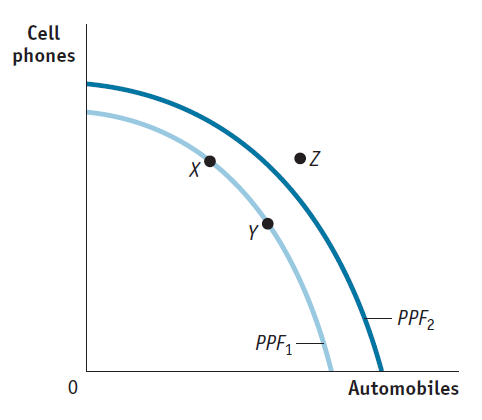
(Figure: Cell Phones and Automobiles) Technological improvements will likely:
(A) shift the production possibility frontier inward to PPF₁
(B) shift the production possibility frontier outward to PPF₂
(C) leave the production possibility frontier unchanged
(D) lead to increased unemployment
(B) shift the production possibility frontier outward to PPF₂
A normative statement is a statement regarding:
(A) the normalizing assumptions of an economic model
(B) what is
(C) what should be
(D) the forecast of a model
(C) what should be
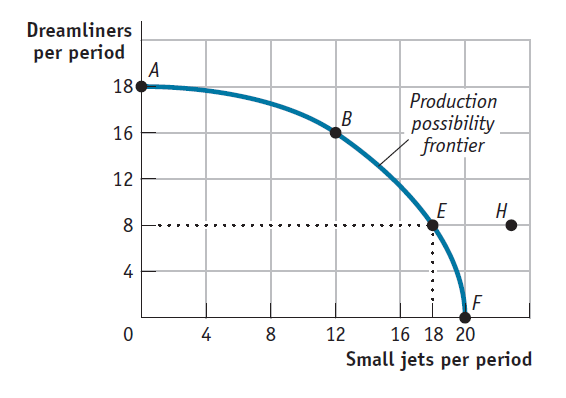
(Figure: Dreamliner and Small Jets) On this figure, points A, B, E and F indicate:
(A) combinations of dreamliners and small jets that society can produce, using all of its factors efficiently
(B) increasing opportunity costs from dreamliners but decreasing opportunity costs for small jets
(C) constant opportunity costs for dreamliners and increasing opportunity costs for small jets.
(D) that society wants small jets more than it wants dreamliners
(A) combinations of dreamliners and small jets that society can produce, using all of its factors efficiently
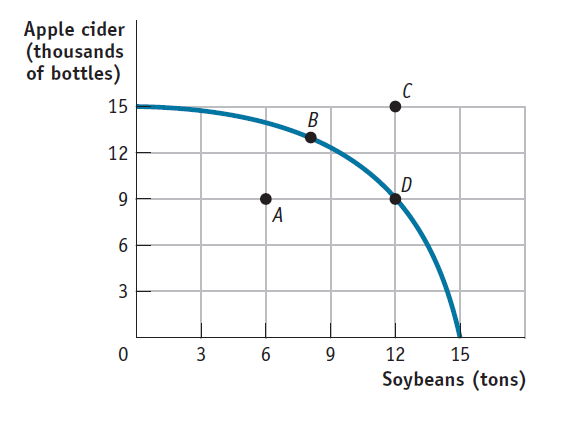
(Figure: Apple Cider and Soybeans) If this economy is producing at point A and wants to produce at point B, it must:
(A) trade with another country
(B) increase its resources
(C) decrease production
(D) use its existing resources more efficiently, as opportunity costs are zero
(D) use its existing resources more efficiently, as opportunity costs are zero
Saying that an unemployment rate of 8% is too high is:
(A) the circular-flow model
(B) a positive statement
(C) an example of absolute advantage
(D) a normative statement
(D) a normative statement
The circular-flow diagram ignores a number of real-world complications in the interest of simplicity. Which of the following factors is ignored?
(A) The role of the market for goods and services in the circular flow
(B) The money flows to factors of production
(C) The flows of money between participants
(D) That many sales that firms make are not to households but to other firms
(D) That many sales that firms make are not to households but to other firms
(Table: Matcha Tea and Coho Salmon Production Possibilities II) This table shows the maximum amounts of matcha tea and Coho salmon, both measured in pounds, that Colombia and Washington can produce if each produces just one good. Colombia has a comparative advantage in the production of:
Matcha tea-
Colombia 40
Washington 10
Coho salmon-
Colombia 20
Washington 10
(A) both matcha tea and Coho salmon
(B) Coho salmon only
(C) neither matcha tea nor Coho salmon
(D) matcha tea only
(D) matcha tea only
An economic model:
(A) often lead to faulty conclusions because of the "all things equal" assumption
(B) allows nothing to change in the economic situation that is being described
(C) is a simplified version of reality used to understand real-world economic conditions.
(D) is useful in explaining past, present, and future economic outcomes
(C) is a simplified version of reality used to understand real-world economic conditions.
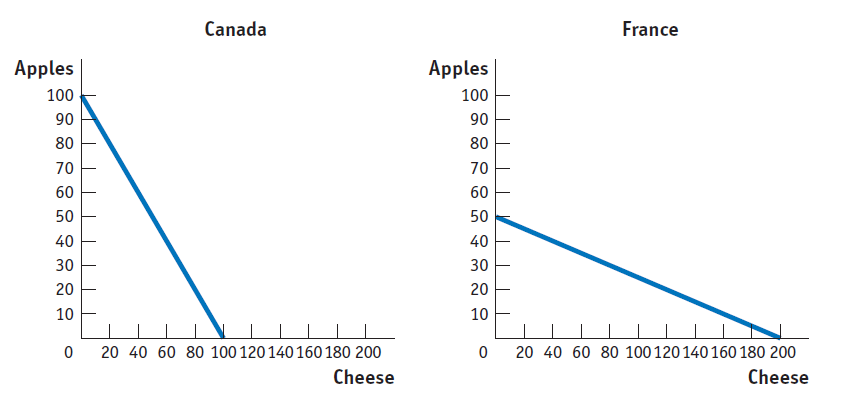
(Figure: Comparative Advantage) Canada has an absolute advantage in producing:
(A) cheese only
(B) apples only
(C) neither apples nor cheese
(D) both apples and cheese
(B) apples only
Trade can be beneficial to an economy because:
(A) it eliminates unemployment
(B) it prevents specialization in activities in which countries have a comparative advantage
(C) it enables more goods and services to be obtained at a lower opportunity cost
(D) it results in a more inefficient use of resources overall
(C) it enables more goods and services to be obtained at a lower opportunity cost
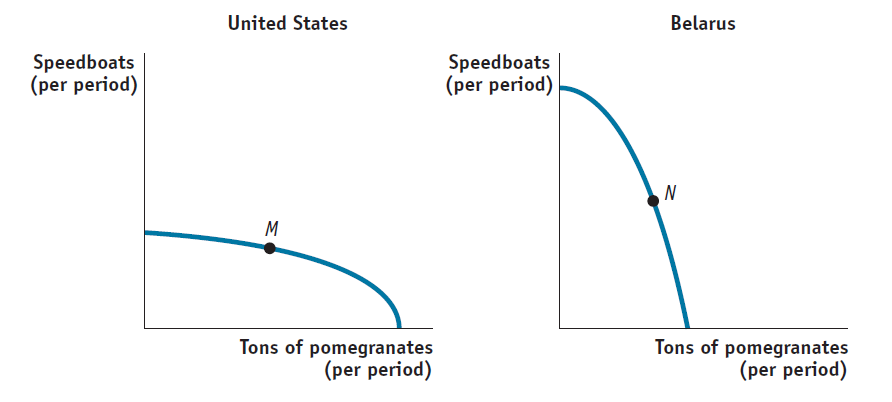
(Figure: Speedboats and Pomegranates I) The figure shows the production possibility frontiers for two countries that produce only pomegranates and speedboats. The axes of the two graphs are measured in equivalent units. The United States is operating at point, and Belarus is operating at point N. The opportunity cost of producing an additional ton of pomegranates would be greater in:
(A) neither, the opportunity cost would be the same in both countries
(B) United States
(C) There is not enough information to answer the question
(D) Belarus
(D) Belarus
(Table: Production Possibilities Schedule I) If the economy produces two planes per period, it can also produce at most, ____ trained per period.
Planes Produced: 0 1 2 3 4 5
Trains Produced: 30 28 24 18 10 0
(A) 18
(B) 24
(C) 28
(D) 30
(B) 24
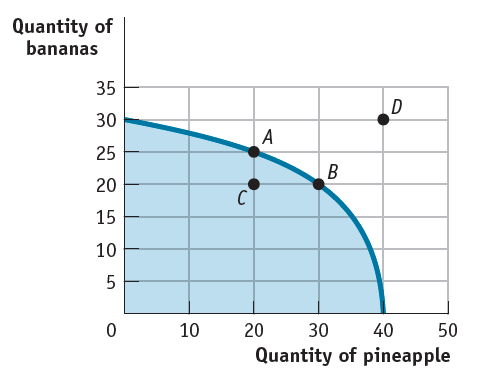
(Figure: Production Possibilities and Circular-Flow Diagram) Assume the two figures represent the same economy. Suppose that in the circular-flow diagram, capital that used to flow to firms producing bananas now flows producing pineapple. This adjustment would be BEST represented in the production possibilities diagram by a move from point A toward:
(A) point D (an outward shift of the entire curve)
(B) point C (a decrease in banana production)
(C) point A (no movement)
(D) point B (a decrease in banana production and an increase in pineapple production
(D) point B (a decrease in banana production and an increase in pineapple production
In a situation in which there are technological improvements, we generally see:
(A) a shift in the production possibility frontier outward
(B) the production possibility frontier unchanged
(C) a transition to increased unemployment
(D) a shift in the production possibility frontier inward
(A) a shift in the production possibility frontier outward